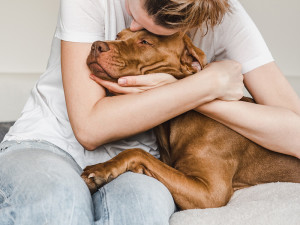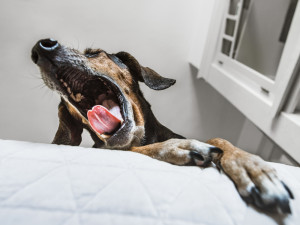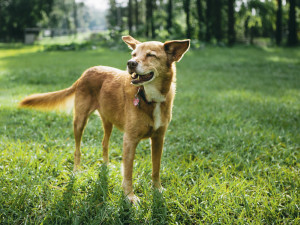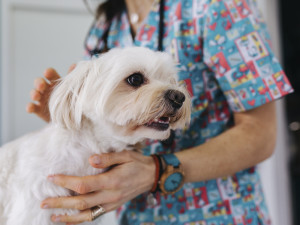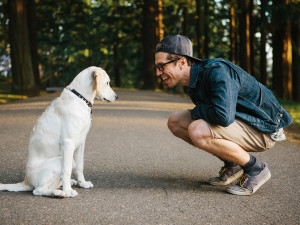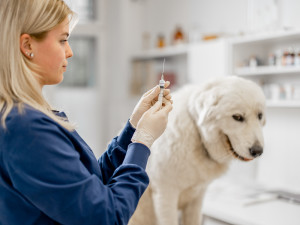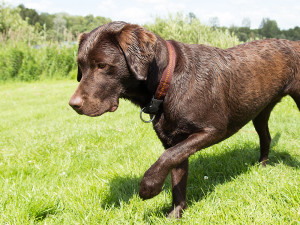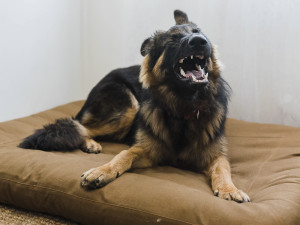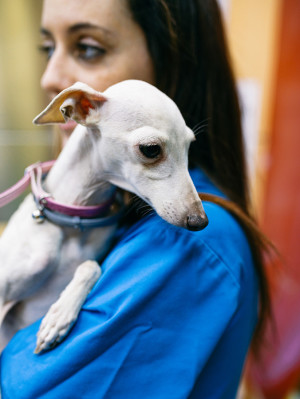Can Dogs Get Colds?
We’re all sniffling this time of year. Learn if your pup can get a cold, too.
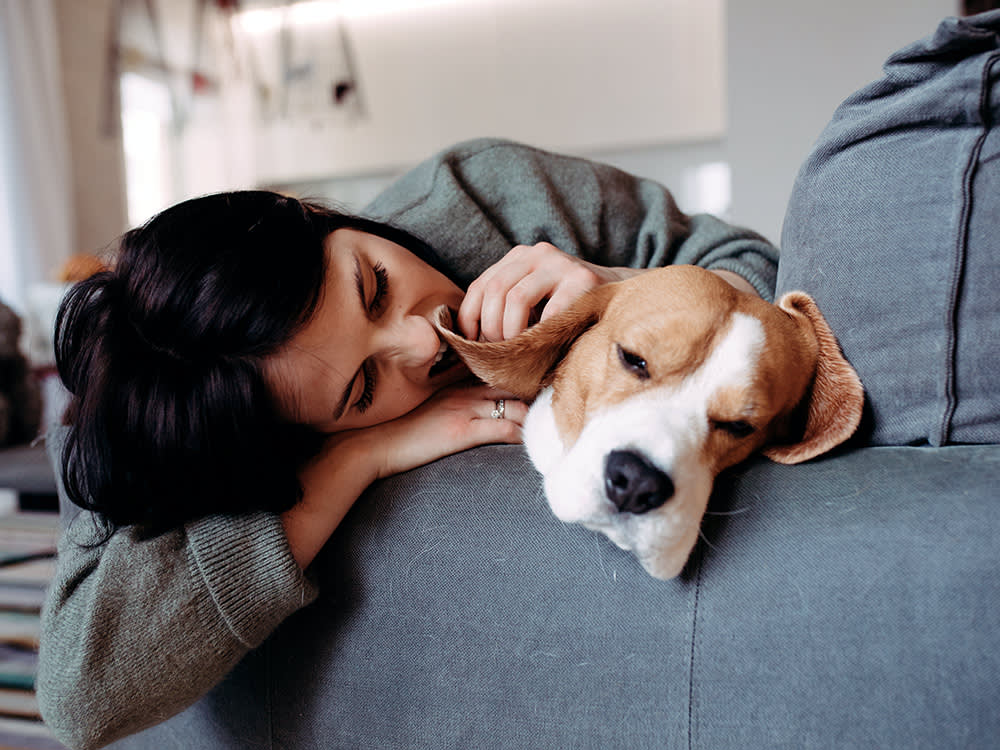
share article

Your pet wants you to read our newsletter. (Then give them a treat.)
In this Article:
Causes of Colds in Dogopens in a new tab Cold Symptoms in Dogsopens in a new tab Treating Dogs with Coldsopens in a new tab Tips For Preventing Colds in Dogsopens in a new tab
Dogs can experience respiratory infections that mimic human colds, but they are not caused by the same virusesopens in a new tab. These infections are usually caused by viruses, such as canine respiratory coronavirus, canine adenovirus type 2, canine parainfluenza virus, or canine herpesvirus. Most canine colds resolve within five to 10 days with supportive care: rest, plenty of fluids, and humid air. If your pup’s symptoms are severe or persist for more than 10 days, consult a veterinarian.
What are the causes of cold-like symptoms in dogs?
Dogs commonly get cold-like symptoms due to bacterial or viral infections transmitted from another pup. Some common viral and bacterial causes of colds in dogs include the following:
Bordetella bronchiseptica
Canine distemper virus
Canine adenovirus type 2
Canine herpesvirus
Canine parainfluenza
Canine respiratory coronavirus
Mycoplasma bacterial species
The symptoms of these bacteria and viruses tend to overlap, so cold-like symptoms in dogs are usually just generally referred to as canine infectious respiratory disease complexopens in a new tab. This disease complex covers the varied causes for colds in dogs. The most common agents responsible for dogs getting sick vary from region to region and country to country. Tests are availableopens in a new tab to determine which specific disease a dog has, but your vet might not recommend a test for a mild cold because they are usually self-limiting.
Dogs can infect other dogs by direct contact, expelling respiratory secretions (coughing or sneezingopens in a new tab), or transmitting agents on objects (like clothes). Some pups can carry viruses or bacteria that can make other dogs sick but not show signs of disease themselves. These asymptomatic carriers make it extra important to keep your dog’s vaccines up to date.
Dogs are exposed to viruses from other dogs all the time but don’t always get sick. There are some things that can make canines more likely to develop a cold. Decreased immune function as a result of a disease (such as Cushing’sopens in a new tab or diabetes) or medication (such as prednisone) can make it harder for your dog to fight off a cold. Added stress caused by boarding, pregnancy, transport, or surgery can also predispose pups to developing a cold. Dogs who have had a herpesvirus infection previously are particularly sensitive to recurrences during times of stress.
What are the symptoms of colds in dogs?
The signs of a cold in a dog are very similar to those in a human, but those who have been infected may make some different sounds than people do. Some common symptoms of colds in dogs include:
Runny nose: Discharge from a dog’s nose can be caused by many conditions, but a snotty nose is a classic symptom of an upper respiratory infection. The liquid is usually clear or white, but dogs with more severe infections may develop yellowish, greenish, or bloody discharge.
Coughing: Coughing is another frequent symptom of colds in dogs, so much so that Canine infectious respiratory disease is more commonly known as “kennel coughopens in a new tab.” Coughs are often described as hacking and may have a non-productive retch or gag at the end.
Sneezing: Just like people with colds, dogs will often experience fits of sneezingopens in a new tab due to a runny nose and nasal irritation. Dogs can even experience something called “reverse sneezingopens in a new tab,” in which they make a very dramatic snorting/wheezing sound as they try to clear mucus from the back of their throat.
Eye discharge: Crusty or goopy eyes can also be seen in dogs with colds. They may have reddened eyes and discharge that is white, yellow, or green in color.
Fever: Dogs with more severe colds may develop a fever. This can simply be because their body is fighting off a virus, but it could also indicate a more severe problem like pneumonia has developed.
Loss of appetite: Most dogs with colds maintain a healthy appetite throughout their illness. If they have more severe infections or nasal congestion, they may not eat as well as they normally do.
Lethargy: Surprisingly, most dogs with colds remain active and playful throughout their illness. Mild lethargy can still be expected in the worst part of the sickness, but severe lethargy is not a normal part of a cold and could indicate a problem.
Difficulty breathingopens in a new tab: Some dogs will pant more while they have a cold because of nasal congestion. True difficulty breathing is possible if the infection moves to the lungs, so watching out for any signs of labored breathing or pale/bluish gums is vital.
How do you treat a dog with a cold?
Most dogs with colds will not require much treatmentopens in a new tab. Upper respiratory infections in pups are usually mild and self-limiting, with the body being able to fight off the infection within seven to 10 days. It’s important to isolate your pup from dogs who aren’t their housemates (who are likely already exposed by the time symptoms develop) to prevent spread of the disease. At home, watchful waiting is generally recommended. Keep an eye out to make sure your dog is:
Eating and drinking well
Remaining active and playful
Sleeping comfortably
Breathing normally
Veterinary treatment of a cold in dogs often revolves around suppressing coughing. Some dogs develop a severe cough that interferes with sleeping, eating, and drinking. After checking for signs of pneumonia, your veterinarian may prescribe a cough suppressant to keep your dog more comfortable as they recover. Do not give over-the-counter cough suppressants unless advised specifically on the medication and dosage, because some cough suppressants contain ingredients that are toxic. Antibiotics are usually needed for pneumonia but are not routinely necessary for uncomplicated colds.
When do I need to take my dog with a cold to the vet?
Some dogs will develop colds that are severe enoughopens in a new tab to require veterinary care. Puppies, unvaccinated dogs, and immunosuppressed dogs are most likely to be badly affected by colds. Signs that could indicate it’s time for a trip to the vet include:
Loss of appetite
Vomiting
Severe yellowish or greenish eye or nose discharge
Symptoms lasting more than 10 days
Lethargy
Constant coughing
Inability to sleep
Difficult or labored breathing
Fever
Pale or bluish gums
Dogs may start off with a mild cold that progresses to a secondary bacterial infection or pneumonia. Catching these early can make treatment much easier, so always talk to your vet or get your dog examined as soon as possible if you have any concerns about their symptoms. Just give the vet’s office a heads-up first so that they can prepare an area to keep your dog isolated from other dogs and people.
What are some natural remedies to effectively treat a cold in a dog?
Natural remedies to treat colds in a puppy or adult dog are limited. At-home care centers around watching for any progression of symptoms, maintaining a good appetite and hydration, and keeping general grossness to a minimum.
Cleaning snotty noses and goopy eyes can help dogs feel more like themselves. For dried discharge, use a damp, lukewarm washcloth to soften the crusts for a minute or two before gently wiping them away. For pups with a stopped-up nose, you can try keeping your dog in a small bathroom for 10 to 15 minutes while leaving a hot shower running. The steamy air can help to loosen up material in their nostrils, allowing them to sneeze it out. Try this before mealtimes so that they’re able to smell and taste their food better.
Can you prevent your dog from getting a cold?
Many dogs get colds without a known exposure to another dog with a cold, so it can be hard to know how some illnesses can be prevented. However, there are some preventive tips for coldsopens in a new tab in dogs, including:
Stay up to date on vaccinations
Avoid contact with sick dogs
Keep away from crowded kennels or dog parks
Watch for reports of dog respiratory illness in your community — avoid doggie daycare and boarding during those times
Steer clear of known stressors for your dog
Even doing everything right, it’s possible that your dog can get a cold. Fortunately, colds in canines are similar to those in people — annoying, but rarely serious. With some time and TLC, your dog should be back to their normal activity before long.
FAQs (People also ask):
Can dogs get human colds?
Dogs cannot get human colds. Dog and human colds are caused by similar types of viruses, but the specific viruses that cause colds in humans and dogs do not cross between the species.
Can I give my dog over-the-counter cold medications?
Do not give over-the-counter cold medications to your dog. Some over-the-counter cold treatments contain ingredients that can be deadly. Only give medications that your veterinarian advises.
References:

Dr. Bartley Harrison, DVM
Dr. Bartley Harrison, DVM is a small animal veterinarian based in North Carolina who has practiced emergency medicine since graduating from the Texas A&M College of Veterinary Medicine. His primary interest areas include pain management, cardiology, and the treatment of shock.
He is a member of the Veterinary Emergency and Critical Care Society, American Veterinary Medical Association, and American Medical Writers Association. In addition to his clinical work, he writes pet health articles to help provide accurate information for both new and experienced pet parents. When he’s not working, he enjoys cooking, traveling, reading, and going on adventures with his dog.
Related articles
![man and lab puppy on park road]() opens in a new tab
opens in a new tabWhen, Exactly, Should You Vaccinate Your Puppy?
If it’s time for a round of shots (no, not that kind), follow this guide.
![Veterinarian holding syringe with vaccine near big white dog in clinic]() opens in a new tab
opens in a new tabTiter Tests: An Alternative to Annual Vaccinations?
Learn about how this test can help protect your pup.
![Brown Labrador lifting front leg]() opens in a new tab
opens in a new tabHow to Get a Head Start on Your Pet’s Health
Spot lumps, limps, and lethargy early on.
- opens in a new tab
Reverse Sneezing in Dogs: Causes and Treatment
Don’t panic: It’s called reverse sneezing, and in most cases, it’s nothing to worry about.
![Young woman carrying cute Italian Greyhound while working in modern veterinarian clinic.]() opens in a new tab
opens in a new tabA Mysterious Illness Is Making Dogs Across the Country Sick
Here’s what we know — and how to protect your pup.
![Dog laying down in dog bed and coughing]() opens in a new tab
opens in a new tabWhy Is My Dog Coughing?
Seven reasons to be concerned when your dog is coughing.
